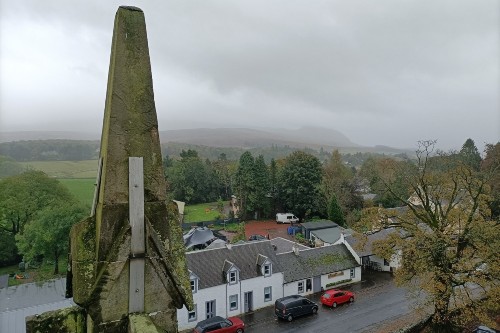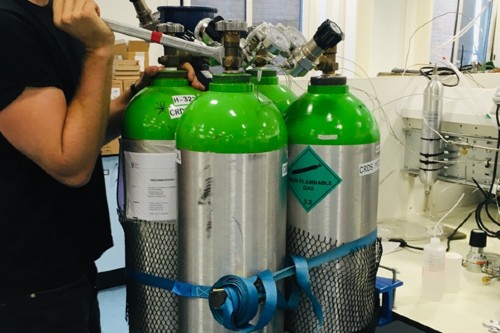
Measurements of carbon dioxide and methane are being made at COP26 from the Glasgow Science Centre Tower, as pictured, in central Glasgow. National Physical Laboratory

Measurements of carbon dioxide and methane are being made at COP26 from the Glasgow Science Centre Tower in central Glasgow and at a rural site north of Glasgow in Killearn, as pictured. Measuring simultaneously from a rural and urban location enables elevations in emissions from the city to be seen more clearly. National Physical Laboratory

Real-time measurements of carbon dioxide and methane are made using high-precision laser based instrumentation. These measurements are used with computer models based on meteorological data to produce "bottom-up" emissions estimates. To ensure robust and accurate GHGs measurements are made, instruments require a suite of calibrated air in high pressure cylinders, as pictured. National Physical Laboratory
Leading atmospheric scientists are measuring emissions of the most dangerous greenhouse gases at COP26 and sharing them live online to highlight how rigorous measurement and detailed data reporting are essential in the fight against climate change.
The initiative, by the University of Bristol and an international team of scientists, deploys sophisticated instrumentation to measure the amount of carbon dioxide (CO2) and methane (CH4) – the main culprits in driving global warming – present in the air in Glasgow, where this year's United Nations Climate Change Conference is being hosted.
The same technology is used in a wider Bristol-led project in partnership with the Met Office to gather this data from across the UK, called the Deriving Emissions linked to Climate Change (DECC) network. This globally unique system is used to check the accuracy of the UK government's greenhouse gas emissions report to the United Nations.
Experts from the team are involved in events and presentations at the 13-day summit to demonstrate how timely measurements present a vital but little-used tool to accurately monitor and effectively tackle climate change.
Prof. Matt Rigby, Professor of Atmospheric Chemistry at the university's Cabot Institute for the Environment, said: "The UK is world-leading in its evaluation of emissions of greenhouse gases, including the two which pose the biggest threat to our planet. The aim of this work is to demonstrate the huge potential of this technology, and urge other countries to follow, especially the industrial powerhouses of China, the US, and India."
A feed of the Glasgow data in real time is available on an online dashboard and the statistics are being carefully analysed by the team to identify possible trends and issues.
Professor Rigby said: "Advanced measurement and tightly-scrutinised evaluation of emissions is imperative to detect any irregularities which may warrant further investigation and to enable countries, including the UK, to meet crucial targets to curb emissions and limit global warming. This approach can help ensure accurate, consistent, and reliable emissions reporting to build and evidence progress."
Government reporting of Greenhouse Gases (GHGs) is based on "bottom-up" or inventory accountancy methods, which calculate the national total contribution to climate change by estimating emissions from individual gas leaks, cars, cows, etc., and adding up the total number of each contributor. Although comprehensive, they can be subject to substantial inaccuracies. These reports do not generally consider arguably key information: measurements that can indicate the actual amount of greenhouse gas in the atmosphere.
By contrast, the team measures real-time levels of GHGs in the atmosphere across the UK and uses computer models based on meteorological data to produce "top-down" emissions estimates. The UK was the first country to use this measurement-based approach to evaluate its GHG emission reports to the UN and is currently one of only three countries, including Switzerland and Australia, to do so.
Professor Alistair Manning, an atmospheric modelling expert at the Met Office, added: "As the UK government routinely cross-check with their figures against our top-down emissions estimates, the credibility of the UK reporting is greatly enhanced. By raising awareness of these methods at COP26 we hope that other countries will be encouraged to follow the UK's lead, in turn improving the accuracy of the global emissions reporting system, which needs to become more consistent and robust."
Members of the public are invited to join a free online event next Thursday afternoon, 11 November, to learn more about the important role measurement plays in understanding and responding to climate change.
The Glasgow measurements are being made by the University of Bristol, National Physical Laboratory, the BEACO2N project at Berkeley, the University of Cambridge, Royal Holloway University of London and the University of Strathclyde. The live dashboard was developed as part of the OpenGHG project.






